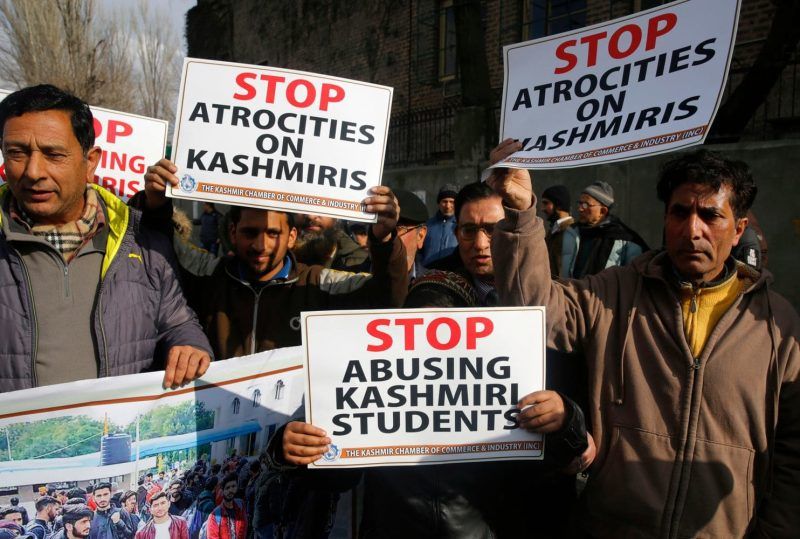
Last Thursday, a 20-year-old Kashmiri by the name of Adil Ahmed Dar blew up a convoy of 45 Indian soldiers in the area of Pulwama, located in the Jammu and Kashmir region.
It was the heaviest loss encountered by India in the region since the armed rebellion began in 1988. Battle cries are mounting; Kashmiris are simultaneously being targeted and punished in a number of Indian cities. In the midst of jingoistic fervor in India, the root cause of violence in Kashmir — the Indian occupation — is being completely overlooked.
Dar had joined the militancy in March 2018, under the Jaish-e-Muhammad, whose leader, Masood Azhar, is based in Pakistan. He was part of a generation that grew up during the Kashmiri “intifada,” a mass movement for freedom that emerged in 2008 and was repeatedly quashed by India.
India immediately blamed the attack on Pakistan, which denied any involvement.
There has been a huge outcry from all sections of the Indian population — politicians, celebrities, journalists and the common masses — to avenge the attack, demanding a war against Pakistan and collective punishment for Kashmiris, including calls for genocide.
Since the attack on the convoy, Kashmiri Muslims living and studying in India have been targeted by mobs; students in Indian colleges have been beaten up and forced to evacuate, while others are in hiding; landlords are kicking Kashmiris out of their homes; and traders have had their shops ransacked. In the Hindu-majority province of Jammu, a curfew was declared as Hindutva mobs attacked Kashmiri homes and businesses and set their cars on fire. If there was any doubt that most Indians do not consider Kashmiris as their own, and only lay claims on the land, that doubt has been effectively quashed.
Meanwhile, in an attempt to gain political mileage out of the horrific attack, Indian politicians and political commentators like Barkha Dutt have blatantly misrepresented and obfuscated the realities on the ground in Kashmir, painting simplistic pictures of “Islamic radicalization.”
Any understanding of what is happening in Kashmir today must account for the Indian state’s belligerent policies and the rampant Hindu nationalism that has gripped India. The trope of Islamic radicalization fails to account for the structural violence that is embedded in the day-to-day lives of Kashmiris living under a military occupation. Despite Indian assertions that Kashmir is an “integral part” of India, Kashmir is an occupied territory, and has been disputed between India and Pakistan since 1947.
Over 700,000 Indian forces are stationed in the region, ostensibly to rid the area of a few hundred militants that it believes are sponsored by Pakistan, but primarily to hold the population, which adamantly rejects Indian rule, completely captive.
Most Kashmiris prefer to remain independent, while some seek merger with Pakistan. Since 1947, Kashmiris have been resisting nonviolently against Indian rule. In 1988, this peaceful movement demanding self-determination evolved into an armed uprising, and over 80,000 Kashmiris have been killed, 8,000 disappeared, and countless more arrested, tortured and raped. If you ask many Kashmiris, they would tell you the Indian army is at war with the Kashmiri people.
Since 2008, India has regularly unleashed live ammunition and lead pellets on protests, leading to massacres of Kashmiri civilians as well as an “epidemic of dead eyes.” These acts of Indian state violence on Kashmiri civilians, unfortunately, never result in international condemnations, marking the kind of erasure that occurs in situations of structural violence.
As tragic as the attack was, it was directed against Indian armed combatants, not against Indian civilians. However, India does not make any distinctions between Kashmiri rebels and civilians: Indian generals and politicians call unarmed protesters “over-ground workers” and give the army a free hand to treat protesters as rebels.
In the past three years alone, over a thousand civilians and rebels have been killed. India repeatedly flouts international norms when it comes to Kashmir, targeting protesters above the waist, attacking hospitals and ambulances — an action that amounts to war crimes — using human shields, targeting journalists in the line of duty, and placing restrictions on freedom of speech and movement.
The mob-like fervor that continues to grip India has never been replicated in Kashmir. In the past three decades of massacres and human rights violations against Kashmiri civilians committed by Indian forces, Kashmiris have never turned against Indian civilians and tourists in their midst.
The Joint Resistance Leadership in Kashmir issued a statement saying that the “people and leadership of Kashmir regret every killing that happens in Kashmir.”
It will not be Pakistan that bears the brunt of the attack, it will be innocent Kashmiris. Yet, amid the warmongering, many in Kashmir are also asking why the attack occurred now, weeks before the Indian election, and why the massive intelligence infrastructure was not able to prevent it. It is clear that Prime Minister Narendra Modi, whose government has failed to provide jobs and engaged in a number of economic and political blunders, would use these attacks to usher in popular support before the elections. Kashmir has always been a way for the Indian state to assert itself in moments of crisis.
The time has come for an honest conversation about the root causes of the “problem of Kashmir”: the Indian occupation and the historical denial of Kashmiri self-determination. Until then, we will continue to count the bodies of those who are killed— both Kashmiri and Indian.
Hafsa Kanjwal is an assistant professor in South Asian history at Lafayette College. Her PhD, from the University of Michigan in Ann Arbor, was on the social history of modern Kashmir.
